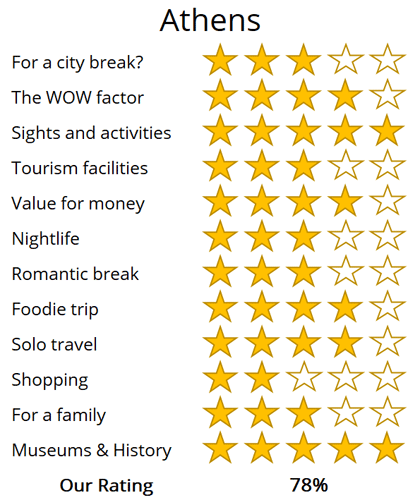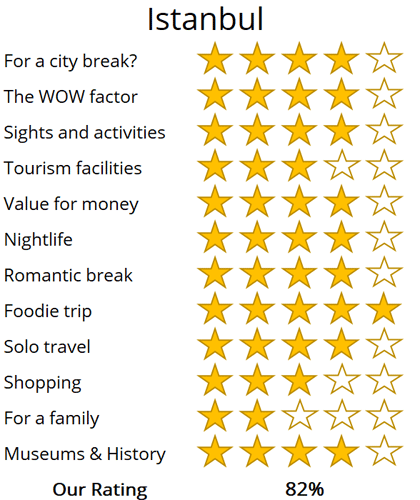WhereToGoForMyHoliday.com
The best destination comparison site!
WhereToGoForMyHoliday.com
The best destination comparison site!
Athens or Istanbul a vs city comparison and travel guide
Athens and Istanbul both offer unique and enticing experiences, but which one should you choose for your city break or holiday?
We understand your dilemma. There is an abundance of travel guides for both cities, but few actually comparing them, and advising you which is the better for your trip.
This article will provide our unbiased and independent views of Istanbul and Athens, hopefully making your choice that little easier.
The article is structured into several sections, each of which can be directly accessed through the following links:
• Introduction to the cities
• Scores and ratings
• Which one should I, friends, or family visit?
• When to visit and weather
• Who is the city suited for?
• The perfect 48hours (with map)
• Tourism details (where to stay? airport details?)
Introduction to Athens and Istanbul
Athens, a city where antiquity meets modernity, invites travellers to embark on a journey through time. The Greek capital, steeped in history, proudly displays its ancient treasures while embracing the vibrancy of contemporary life.
The Acropolis stands as a monumental testament to Athens' glorious past, offering awe-inspiring views and a palpable connection to the city’s ancestors. Down below, lively neighbourhoods and trendy cafes showcase the modern Athenian spirit.
Whether indulging in delectable Mediterranean cuisine, exploring historic ruins, or wandering through charming streets, visitors are sure to be captivated. Athens is not just a destination; it’s an invitation to adventure, a place where the past and present dance together in harmonious splendour.
Istanbul is one of the most captivating cities in the world, situated on the banks of the Bosphorus. It straddles Europe and Asia, offering a unique blend of East and West. The city's rich history is evident in its grandiose architecture, from the 6th-century Hagia Sophia to the 16th-century Topkapi Palace.
You can wander through ancient markets, explore the shadowy streets of the Ottoman Quarter, or relax in one of Istanbul's many parks. With its vibrant culture and stunning setting, Istanbul is a city that will stay with you long after you've left.

The Acropolis stands high above Athens

The Blue Mosque in Istanbul
Athens vs Istanbul: City Ratings
Summary
Where would I journey for a personal escape?
Istanbul
Where would I send my parents for a memorable visit?
Athens
Where's the ideal destination for my adventurous 19-year-old cousin?
Istanbul
Where should my food-obsessed friend indulge their culinary passions?
Athens
Note: The above comparisons are weather-independent and are based on travel during the most opportune times of the year. Details about the ideal travel seasons are elaborated upon later in this article.
In the sections that follow, you'll find a comprehensive comparison between these two fascinating cities. This includes recommendations on the duration of stay, the best times to visit, and tailored 48-hour itineraries for each city.
The final segment delves into practicalities for your travels, such as the best airport to fly into, the optimal districts for your accommodation, and insider tips, for when you come to explore the city.
We hope that you find all of this information useful, in planning your next exciting trip!
Destination details
How long to spend each city?
Istanbul is a city that you could spend weeks exploring and still not see everything it has to offer. Three days is the best length, however, if you only have one day to spend in Istanbul, you can still see some of its most iconic sights, such as the Blue Mosque and the Grand Bazaar.
With two days in Istanbul, you could visit some of the city's most popular attractions, such as the Topkapi Palace and the Hagia Sophia. You can also take a cruise on the Bosporus Strait and explore the city's many markets and mosques.
Athens can be sampledin a few days, but it can also warrant trips of a few weeks or more. It all really depends on what you want out of your visit. If it's a whirlwind tour of the famous 5th-century history sights (the Acropolis, the Parthenon, the Agora), some Greek mezze, and a good night out that takes your fancy, then a weekend could be enough.
If you want to feel like a real local, sip gritty Greek coffees in corner bars in alt neighborhoods, and even escape to the islands to top up the tan, you'll need to plan longer.
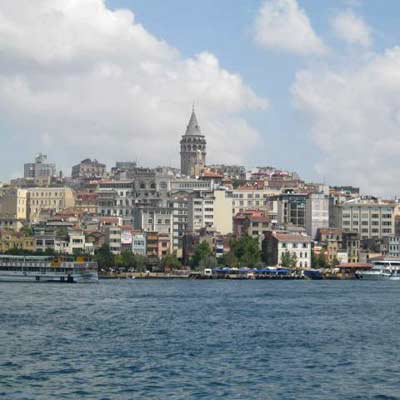
The Beyoglu district in Istanbul with the medieval Galata tower rising above this historic section of the city

The National Archaeological Museum, houses the world’s finest collection of Greek artefacts
Athens is most popular in the summer months, but we'd say it's not the best time of year to come. Temperatures in Greece can be scorching between June and August, with daily highs peaking around the 40 Celsius mark!
Much better are the shoulder seasons of spring and autumn. These see warm days and cool evenings of between 16-29 degrees on average. It's still usually dry, with the occasional cloud and rainfall. However, there are also fewer people around, cheaper hotels, and smaller queues for the ancient ruins.
Winter in Athens gets surprisingly cold. Snow can even fall in the height of the season. It's the best if you really don't like dodging other tourists though, with the museums and the galleries all virtually empty. Be warned that ferries to nearby islands like Poros and Aegina rarely run between November and March.
When things get hot in Istanbul, things get really hot. In fact, it's not uncommon for summertime temperatures to creep over 30 degrees. What's more, June to August is when the crowds come, packing out sights like the Grand Bazaar.
The upshot here is that spring and fall reign as the top times in the calendar to plan a visit. March, April, September and October tend to be cooler, less busy and less expensive.
Winter can bring snows. Photographers will adore the city when it's blanketed, as the Hagia Sofia and the Blue Mosque look simply stunning under a sheen of the white stuff. However, the months from November to February can be bitterly cold, so off-season visitors will need to wrap up warm and forget having al fresco Turkish coffees on the street side.
Istanbul presents itself as an adventurous and unconventional getaway for European travellers, standing in stark contrast to the typical package holiday with pre-arranged accommodation by the sea.
Here, visitors are immersed in captivating Ottoman history and bustling bazaars, encouraging them to step out of their comfort zones and expand their horizons.
However, those seeking a compact, easily navigable city may find Istanbul overwhelming. Home to 15.5 million residents and spanning two continents, Istanbul is vast and sprawling, far from a small-scale destination.
The history lover is the traveller who will surely feel most at home in Athens. After all, this is the place of the mighty Parthenon; where the Athenian Empire once flourished. And it's got Orthodox temples and some of the most acclaimed ancient artifact museums on the globe to top the lot off. You can spend whole trips hopping between crumbling temples and learning about the hard-fought Peloponnesian War, without even scratching the surface of the amazing daytrip possibilities.
Aside from its famous historical relics, Athens also has a reputation for hedonism. Districts like anarchist Exarcheia come laced with squat bars and buzzy pubs. There's also pumping nightlife around the Plaka area, where you'll be able to dine on endless platters of saganaki cheese, hummus, and grilled lamb before heading out to dance the Zorba.
If you're planning a Greek beach holiday, then Athens is a good arrival point. You're likely to be a little disappointed if you hang around too long, though. The only sands within reach of the centre are in Vouliagmeni to the south and they certainly aren't the best in the country.

The delightful Pláka district, is a maze of narrow streets on the northern slopes of the Acropolis
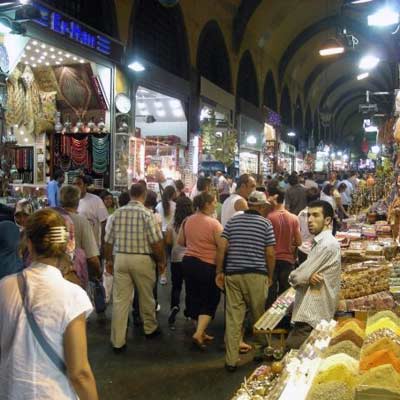
The lively and chaotic Grand Bazaar in Istanbul
You can unearth some seriously jaw-dropping sights, taste some unforgettable food, and get a grounding in Turkish history with only 48 hours to spend in Istanbul.
Day 1: The perfect starting point is Sultanahmet, epitomizing the iconic imagery of Istanbul with its minarets and grand mosque domes. Dominating the skyline is the colossal Hagia Sophia, a historic gem with over 1,500 years of history, transitioning from an Orthodox cathedral to a mosque, and now a museum. Inside, visitors are captivated by exquisite mosaics and frescoes, with the dome, boasting a remarkable 30-metre diameter, being the centerpiece.
Directly to the south sits the majestic Blue Mosque, constructed in the early 1600s and still in use today. A short walk northwards takes you to the Topkapi Palace Museum, once the residence of Ottoman sultans, now a UNESCO World Heritage site commanding a magnificent view over the Bosphorus.
Ensure you make a stop at Tarihi Sultanahmet Kofta House, renowned since the 1920s for its traditional Turkish meatballs.
From there, it's not far to the Grand Bazaar. One of the world's largest markets, it's a haven for haggling and souvenir shopping, where lantern sellers converge on sari stalls and shisha houses.
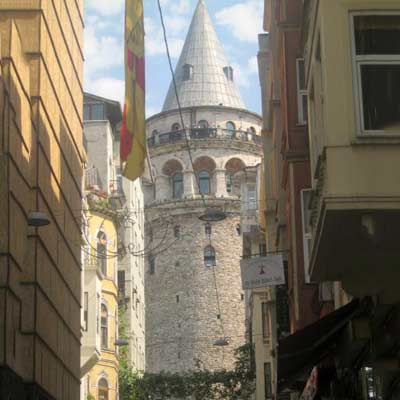
Galata tower is at the heart of the Beyoglu district
Day 2: Big, modern Taksim Square starts day two with a sighting of what 21st-century Istanbul is all about. Be sure to take a glimpse of the honorific statue at its heart.
That's the Republic Monument, made to celebrate the foundation of the Turkish state in 1928. Nearby Istiklal Street has abundant choices on the food front, no matter if you're craving a gritty Turkish coffee or a regional breakfast spread of mezze cheeses, flatbreads, and olives.
It's also a busting artery of the city, with high-street shopping and a classic trolley car running its length. One thing you can't miss – literally! – here is Galata Tower. Built by the Genoese to protect their European strongholds from the east, it's a mind-blowing fortification that boasts sweeping panoramas from its top floors.
Your afternoon session should be dedicated to exploring the Bosphorus. There's really no better way to do that than on a boat. Some cruises even offer stops in Asian Istanbul and meals with the sunset to boot.
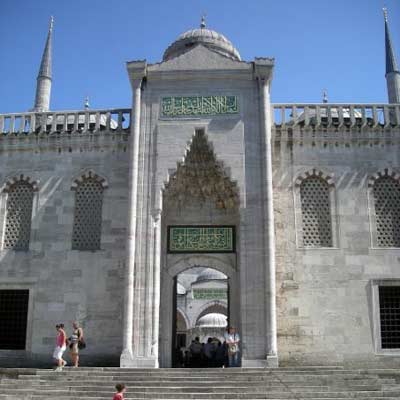
The entrance to the Blue Mosque
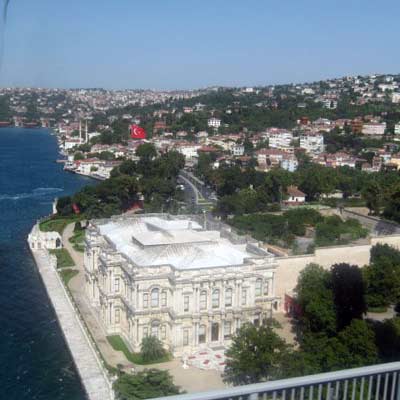
The Beylerbeyi Palace was the summer residence of the Sultan
48hours in Athens
Searching for an all-round fantastic 48 hours in the Greek capital? Look no further. This culture-packed and monument-filled itinerary whizzes you through all the mainstay sights and even into some downright gritty local districts. Enjoy…
Day 1: Start as early as you can and head straight through the Plaka area up to the base of the Acropolis. The best way to reach that grand monument is via the winding roads that link up the tavernas with the great Propylaea gatehouse that dates to 437 BC. It was commissioned by Perikles in the aftermath of the Persian War and leads to the symbolic heart of ancient Athens: The Parthenon.
Getting there early means you can hopefully dodge the crowds and the heat. Take some time to wander to see the hulking columns and design – it's considered to be the finest Doric temple on the planet. The next-door Erechtheion also catches the eye. It was built after 421 BC in honour of Poseidon and Athena, famed for its Caryatid statues of female figures. A lookout point on the south-east end of the Acropolis is perfect for taking in the city views.
For lunch, go for the vibrant area of Koukaki, checking out the Theatre of Dionysus en route. It's filled with hip cafeterias and bakeries, all huddled under plane trees and bougainvillea. It's a short walk from there to the acclaimed Acropolis Museum. You can while away the whole afternoon within, uncovering the story of the legendary building and the politics it represented.
Think about ending the day with a walk through the pine trees to Filopappou Hill. That's home to the place where Socrates was imprisoned in the early 390s BC and tops out with some of the most stunning views of the Acropolis there are.

The Parthenon was dedicated to the Greek goddess Athena, who is regarded as the patron of the city
Day 2: The café culture of Monastiraki gets the day rolling – think about grabbing a traditional Greek coffee and pastry in one of the local bakehouses. A quick stroll through the blocks southwards then takes you to the Agora.
That was the epicentre of life in the ancient city state, complete with shrines and marketplaces and statues. The piece de resistance is the Temple of Hephaestus, which crowns a hillside on its northern end. Nearby, the blocks of Syntagma and Syntagma Square offer a glimpse at the modern edge of the Greek capital.
The vast plaza at the area's heart hosts the Old Royal Palace of the Greek monarchy. There are also countless places to sit with a cold lunchtime beer. Finished? Go south and you'll find the mighty Temple of Olympian Zeus. It is half ruined but still draws a gasp from most visitors on account of its monstrous Corinthian columns.
In the afternoon, catch a tram towards the National Archaeological Museum. Inside, you'll discover perhaps the richest collection of ancient artifacts there are in the world.
What's more, the district on the doorstep is Exarcheia. Be careful with your valuables in those parts, because it's rough and gritty, but the streets ooze character and have perhaps the most hedonistic bars in the country.

The Old Parliament House served as the parliament building until 1935
The modern Istanbul New Airport is the main hub serving this big city. It handles the largest amount of air traffic in Turkey, so expect to find lots of connections in from Western Europe and beyond. Regular shuttle buses link the terminals with the downtown in around 50 minutes to one hour, but, be warned, travel times can vary greatly depending on traffic. The smaller Sabiha Gokcen International Airport hosts most of the services coming in from across the Middle East. It's over on the south side of the metropolis.
Public transit in Istanbul is just what you might expect from a vast, consistently expanding megacity. The best way to go about getting from A to B is to bag yourself an Istanbulkart. It's an all-in-one pass to the town's multi-faceted transport networks, allowing holders to use buses, trams, trains, metros, and even a few of the ferries. You'll need to buy your card from a kiosk and then top it up with credit to make journeys.
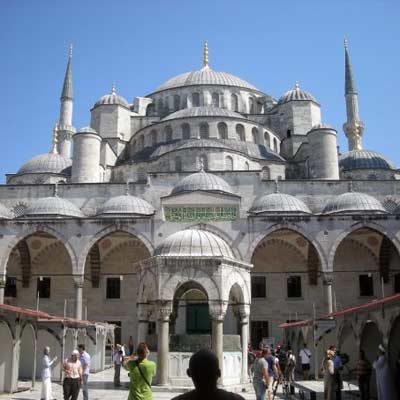
The Sultan Ahmed Mosque
Istanbul's tourist areas suffer from the same scams as many other European cities. Fake guides, pickpockets and unregistered taxis are particularly common, so be sure to have your wits about you when sightseeing. Be wary when converting cash in the Old Town area too, because extortionate commission rates and even fake banknotes have been reported.
Choosing a hotel in Istanbul really depends on what you want. Sightseeing in Sultanahmet is what most people come for and there are loads of hotels to pick there, even if paying a premium is normal. Beyoglu is better if you're after chain hotels and boutique stays, and it's right on the more modern and happening part of town. Asian Istanbul will likely be cheaper, but also a ferry ride from the most famous attractions.
Traveling from Athens airport is best done using the metro. Line 3 links directly to the terminal. The fare is a flat €10 and the journey takes around 40 minutes each way. If leaving the city, be sure to catch the right train, because not all departures on the line go to the same place.
There are some areas that really stand out from the crowd when it comes to finding hotels in Athens. The Plaka is popular for its traditional Greek restaurants and proximity to the ancient sites.
Kolonaki has lots of chain hotels with rooftop pools and breakfast terraces. But Koukaki is also worth considering, for its local vibes and charming B&Bs.

The Theatre of Dionysus
Always beware of pickpockets, muggers, thieves and scams in Athens. The capital is generally safe, but certain areas – the Plaka, Omonoia Square and Exarcheia especially – do see regular crimes against tourists. Try to keep a hand on your wallet and an eye on your bag at all times.
Political upheavals in Athens are a common problem. Widespread discontent with the government has led to regular protests and marches since the 2000s. They can sometimes bring the whole city to a standstill and are worth avoiding – teargas, clashes with police and even Molotov cocktails have been known to play a part.
Getting around Athens is relatively easy. You've got a metro network that links most of the main tourist areas and the airport. Above ground, there are buses and trams going out to lesser known neighborhoods. There are both kiosks and vending machines at the entrance to most stations for you to buy tickets. They cost €1.40 and are valid for 90 minutes from the moment of validation.

oh we were stuck in the airport!

Copenhagen was a bit expensive...

All we did was drink beer in Brussels...

Muncih was crazy

And we got so burnt!

Remeber that night in Rome

oh we were stuck in the airport

So much fun kayaking

Berlin and that group from Austria!

There was such a view from that church

And we got so burnt!

Munich was eventful, wasn't it!

Such a view from that cathedral in Florence

Lisbon was such so much fun

Last summer was so much fun .... x

Remeber that night in Rome

Lisbon was such so much fun

Such a view from that cathedral in Florence

Munich was eventful, wasn't it!

And we got so burnt!

Remeber that night in Rome

All we did was drink beer in Brussels...

Berlin and that group from Austria!

Can't wait to go back to Dubrovnik

Remember that boat ride in Prague

Copenhagen was a bit expensive...
